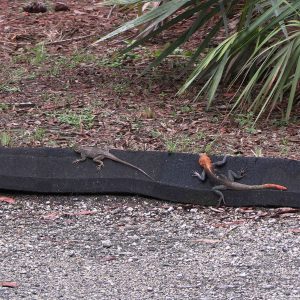Some nonnative reptile species found in Florida are fast and flee quickly from people with cameras. Its recommended that nonnative reptiles be reported using ivegot1 or Eddmaps. Capturing photos and videos can be tricky and often need telephoto lenses. Nonnative lizards such as Peters’s rock agama and brown basilisks can be particularly tricky to photograph or video record. You can read up about Peters’s rock agama and brown basilisks on our UF EDIS documents. I have need of new photos of brown basilisks and Peters’s rock agama because I constantly teach people about nonnative reptiles using media such as PowerPoint Presentations, blogs and social media. The time finally came for me to update my brown basilisk photo library. All it took was a decent camera and a trip to Gordy Road Preserve.

So why now? St. Lucie County has had a significant amount of rain in mid-June 2024 after a prolonged period of dry weather. I decided it was time to stalk brown basilisks because of all the standing water. These reptiles are also known as “Jesus Christ lizards” because they run on water to flee predators. They thrive in damp warm places with standing puddles of water.
I selected Gordy Road Preserve in western St. Lucie County as an ideal place to stalk brown basilisks with my camera. This property is adjacent to 10 Mile Creek which is the headwaters of the North Fork of the St. Lucie River. I saw them there in the past and I figured they would still be there. And I was right.
The brown basilisks saw me driving into the parking lot and got up on their hind legs and ran for cover. I was grateful I did not have to go far to find them. With a little patience, I took several decent photos and videos of these brown basilisks.
While at Gordy Road Preserve, I could not help but notice the Peters’s rock agama practically posing for photo ops. Male agama have red heads while female agama have a more-drab coloration. It should be noted that it was not raining when I visited this preserve. I suspect neither of these reptile species would be easy to find if I was stalking them with my camera in the rain.
I hope you enjoy my photos.

Now about those videos. That was trickier – mostly because you cannot get close to either agama or basilisks without having them flee into the brush. I used maximum zoom on my camera and captured short video clips while I took very, very slow steps forward. It was difficult for me to keep basilisks in the camera’s view, and they were well-camouflaged against the fallen leaves and background vegetation.
Overall, I have to admit it was fun stalking these reptiles with my camera. There were certainly plenty of them to take pictures of.



_____________________________
An Equal Opportunity Institution. UF/IFAS Extension, University of Florida, Institute of Food and Agricultural Sciences, Andra Johnson, Dean and Director. Single copies of UF/IFAS Extension publications (excluding 4-H and youth publications) are available free to Florida residents from county UF/IFAS Extension offices.
 1
1
